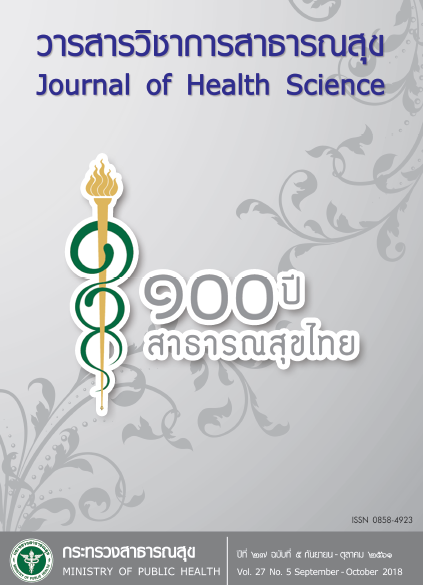Development of an Asthma Management System for Asthma Management at an Integrated Asthma Clinic, Sankhaburi Hospital, Chai Nat Province
Keywords:
asthma, service system, outpatient clinicAbstract
This action research aimed to develop service treatment of asthma patients at outpatients depart-ment, Sankhaburi Hospital. The samples were 5 medical personnel in Asthma Clinic and 62 asthma patients attended the Asthma Clinic at Sankhaburi Hospital. The patients were recruited based on the following criteria: (1) diagnosed as asthma by World Health Organization (WHO) standard classification (J45); (2) had no other chronic diseases; (3) aged 5 years and over, (4) be able to give the information and volunteer to activity participate in the subsequent follow-up assessment (at least 4 sessions). The research methodology of this study was conducted by applying the quality development process of Deming cycle, and consisted of three steps (1) study context the asthma patient care, (2) development of medical care service system for asthma patients, and (3) evaluated results of development. The 2 types of research instruments used for data collection were: (1) instruments used to study the contexts, including the asthma care policy documents, the asthma treatment and the lung function measurement, (2) instruments used in development process of asthma service treatment and outcomes, including questionnaires to evaluate the quality of asthma care, individual patient asthma patient record in computerized system, meeting records, in-depth interview of medical personnel and the satisfaction measurement of patients and service provid-ers. Data analysis was divided into (1) quantitative data analysis, including demographic information such features, social, economic and lung performance. The number of visits to emergency room, the number of re-admission and satisfaction of the patients were analyzed. The statistics used were frequency, percentage and mean; (2) qualitative data analysis, the content analysis was used to analyze the data from meeting information and in–depth interviews of the medical personnel. As for the results, the medical care service system for asthma patient began from the context, the care policy, profession team and asthma clinic. The development process included planning, doing, checking and the changes acceptance for action as follow: (1) the planning step: the system was analyzed by multidisciplinary team in the clinic, meeting and proposed the performance problems, recommended the guideline for problem solving, reviewed the previ-ous treatment, arranged a new treatment method, registered strategic plan, action plan and flowchart of the patients in the clinic, prepared location, materials, and equipment for the services; step 2: the doing step: the action plan was implemented, the patient flow system was applied, the treatment guideline was fol-lowed, and building capacity of the personnel; step 3: checking step: evaluated the quality of asthma care and treatment outcomes; and 4: the changes acceptance for action step: improved the system and developed future action plan. The following results were observed: (1) there was a patient flow guideline in the clinic, the quality improvement plan was developed, and a new standard treatment guideline for asthma patients in the emergency room was available; (2) the clinical result showed that 83.2% of the patients had better lung function. The number of admissions of asthma cases reduced by 62.9%; and there was 11.3% reduction of emergency room visits. The overall service system was at highest satisfaction level with the average score of 4.45.
Downloads
Downloads
Published
How to Cite
Issue
Section
License
Copyright (c) 2018 Journal of Health Science- วารสารวิชาการสาธารณสุข

This work is licensed under a Creative Commons Attribution-NonCommercial-NoDerivatives 4.0 International License.







